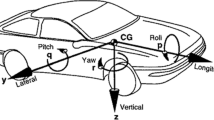Abstract
At conceptual design stage, automotive body is usually simplified as a frame structure, which consists of thinwalled beams (TWBs). Therefore, the most important issue is to determine the cross-sectional shape of TWBs under the requirement of mechanical properties. However, design engineers mostly depend on their experience or repeated modification to design the cross-sectional shape of TWBs. So this paper presents a rapidly cross-sectional shape design and optimization method to satisfy the demand of mechanical properties and meanwhile minimize the weight of TWB. Firstly, cross-sectional mechanics property formulations are summarized. Especially, the torsional rigidity formulation of three-cell cross section is derived for the first time in this paper. Secondly, the shape optimization model is created to minimize the weight of TWB and improve the mechanical properties, which is solved by genetic algorithm. Moreover, three stamping constraints, draft angle, chamfer radius and assembly, are introduced to promote the cross-sectional shape more practice. Lastly, numerical examples verify the effectiveness of the optimization model and show the application in structural modification of automotive frame.
Similar content being viewed by others
References
Gauchia, A., Diaz, V., Boada, M. J. L. and Boada, B. L. (2010). Torsional stiffness and weight optimization of a real bus structure. Int. J. Automotive Technology 11, 1, 41–47.
Griffiths, D. R. and Miles, J. C. (2003). Determining the optimal cross-section of beams. Adv. Eng. Inform. 17, 2, 59–76.
Heo, S. J., Kang, D. O., Lee, J. H., Kim, I. H. and Darwish, S. M. H. (2013). Shape optimization of lower control arm considering multi-disciplinary constraint condition by using progress meta-model method. Int. J. Automotive Technology 14, 3, 499–505.
Kim, Y. Y. and Kim, T. S. (2000). Topology optimization of beam cross sections. Int. J. Solids Struct. 37, 3, 477–493.
Kunishi, D. and Kikuchi, N. (2004). Analysis of FEM results based upon FOA. SAE Paper No. 2004-01-1729.
Lamberti, L. and Pappalettere, C. (2002). Design optimization of large-scale structures with sequential linear programming. Proc. Institution of Mechanical Engineers, Part C: J. Mechanical Engineering Science 216, 8, 799–811.
Lamberti, L. and Pappalettere, C. (2005). An efficient sequential linear programming algorithm for engineering optimization. J. Eng. Design 16, 3, 353–371.
Nakagawa, T., Nishigaki, H., Tsurumi, Y. and Kikuchi, N. (2004). First order analysis for automotive body structure design-Part 4: Noise and vibration analysis applied to a subframe. SAE Paper No. 2004-01-1661.
Nishigaki, H., Amago, T., Sugiura, H., Kojima, Y., Nishiwaki, S. and Kikuchi, N. (2004). First order analysis for automotive body structure design-Part 1: Overview and applications. SAE Paper No. 2004-01-1658.
Nishigaki, H. and Kikuchi, N. (2004). First order analysis for automotive body structure design-Part 3: Crashworthiness analysis using beam elements. SAE Paper No. 2004-01-1660.
Nishigaki, H., Nishiwaki, S., Amago, T., Kojima, Y. and Kikuchi, N. (2001). First order analysis-New CAE tools for automotive body designers. SAE Paper No. 2001-01-0768.
Song, J. H., Lee, G. A., Jung, K. H. and Park, S. J. (2015). Laser irradiated bending characteristics of the ultra-high strength steel sheets. Int. J. Automotive Technology 16, 1, 89–96.
Suh, J., Lee, J. H., Kang, H. S., Park, K. T., Kim, J. S., Lee, M. Y. and Jung, B. H. (2006). Optimal processing and system manufacturing of a laser welded tube for an automobile bumper beam. Int. J. Automotive Technology 7, 2, 209–216.
Tovey, M. (2002). Concept design CAD for the automotive industry. J. Eng. Design 13, 1, 5–18.
Tsurumi, Y., Nishigaki, H., Nakagawa, T., Amago, T., Furusu, K. and Kikuchi, N. (2004). First order analysis for automotive body structure design-Part 2: Joint analysis considering nonlinear behavior. SAE Paper No. 2004-01-1659.
Wang, H., Li, E. Y. and Li, G. Y. (2011). Probability-based least square support vector regression metamodeling technique for crashworthiness optimization problems. Computational Mechanics 47, 3, 251–263.
Wang, H., Li, G. Y. and Li, E. Y. (2010). Time-based metamodeling technique for vehicle crashworthiness optimization. Comput. Method. Appl. M. 199, 37-40, 2497–2509.
Yoshimura, M., Nishiwaki, S. and Izui, K. (2005). A multiple cross-sectional shape optimization method for automotive body frames. J. Mech. Design 127, 1, 49–57.
Yu, K. G. and Yang, Z. H. (2015). Assembly variation modeling method research of compliant automobile body sheet metal parts using the finite element method. Int. J. Automotive Technology 16, 1, 51–56.
Zhou, Q., Wu, X., Xia, Y. and Cai, W. (2014). Spot weld layout optimization of tube crash performance with manufacturing constraints. J. Manuf. Sci. Eng. 136, 1, 1–10.
Zuo, W. J. (2013). An object-oriented graphics interface design and optimization software for cross-sectional shape of automobile body. Adv. Eng. Softw., 64, 1–10.
Zuo, W. J. (2015). Bi-level optimization for the crosssectional shape of a thin-walled car body frame with static stiffness and dynamic frequency stiffness constraints. Proc. Institution of Mechanical Engineers, Part D: J. Automobile Engineering 229, 8, 1046–1059.
Zuo, W. J., Bai, J. T. and Li, B. (2014). A hybrid OC-GA approach for fast and global truss optimization with frequency constraints. Appl. Soft. Comput., 14, 528–535.
Zuo, W. J., Li, W. W., Xu, T., Xuan, S. Y. and Na, J. X. (2012). A complete development process of finite element software for body-in-white structure with semirigid beams in. NET framework. Adv. Eng. Softw. 45, 1, 261–271.
Zuo, W. J., Xu, T., Zhang, H. and Xu, T. S. (2011). Fast structural optimization with frequency constraints by genetic algorithm using adaptive eigenvalue reanalysis methods. Structural and Multidisciplinary Optimization 43, 6, 799–810.
Author information
Authors and Affiliations
Corresponding author
Rights and permissions
About this article
Cite this article
Zuo, W.J., Bai, J.T. Cross-sectional shape design and optimization of automotive body with stamping constraints. Int.J Automot. Technol. 17, 1003–1011 (2016). https://doi.org/10.1007/s12239-016-0098-6
Received:
Revised:
Accepted:
Published:
Issue Date:
DOI: https://doi.org/10.1007/s12239-016-0098-6




